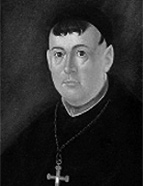

However, when presenting a brief summary of the themes addressed by Cardinal Saraiva, the Marquis of Resende essentially emphasises the historical and literary texts: "As I now turn to indicate the general character of the different writings of Cardinal Saraiva, I will mention the following issues: Ecclesiastical News from Portugal; Archaeology of Ecclesiastical and Secular History; Historical Studies of the various Kingdoms of Portugal up to the 14th century; Historical Studies on ancient Lusitania, and the different Peoples who entered it until the establishment of Portugal's independence; Chronological and Historical Notes; Historical, Literary and Critical News; Navigations, Conquests and Establishments made in the Portuguese Colonies, and others; Various Works on the Portuguese Language" (Resende, "Introduction", p. VI).
One of Friar Francisco de S. Luís' main concerns was the preservation of documents in archives, registries and libraries, particularly the Order of St Benedict. He systematically organised various indexes of the archives in which he worked, making it significantly easier to search for documentation in them. This organisation of the indexes was accompanied by the arrangement of the documents, grouping them by subject. The historical texts written by the Benedictine monk span numerous periods of Portugal's history, with several focusing on the peoples who inhabited the Iberian Peninsula before the establishment of the kingdom. In fact, there is a concern to demonstrate that many of the roots of the Portuguese language and culture derive from the peoples who lived in the territory before its integration into the Roman Empire. In the history texts, he systematically used works by classical authors, as well as texts by various national authors. For Friar Francisco de São Luís, history is a branch of literature and essentially has a moralising function. Another field that was of particular interest to him was the history of the discoveries and expansion. He carried out studies based on documentation relating to the discoveries, organised a chronology of the Portuguese discoveries and published sources such as an itinerary of Fernão de Magalhães' voyage. He reflected on the scarcity of documents on the Portuguese discoveries and offered explanations for this lack. One possible reason for the scarcity of documents is a policy of secrecy, a theory that still has many supporters today. As far as we know, Saraiva was the first to put forward this explanation, although he gives other reasons for the lack of documentation. His role as a historian of the discoveries was highlighted by the Associação Marítima e Colonial [Maritime and Colonial Association], an organisation founded in the 1830s on the initiative of naval officers and other civil society figures who were concerned with maritime and colonial issues. Saraiva was welcomed as a member of the organisation and served as president of the editorial board of the Anais Marítimos e Coloniais. In the association's periodical, he was among the authors who published works defending the primacy of the Portuguese discoveries. His particular interest in this subject can be seen in several of his texts. He denounced the French claims of expansion along the coast of Africa. His "Índice cronológico das navegações, viagens, descobrimentos, e conquistas dos portugueses nos países ultramarinos desde o princípio do século XV" [Chronological index of Portuguese navigations, voyages, discoveries and conquests in overseas countries since the beginning of the 15th century], covering a period from 1412 to 1811, was written to demonstrate the Portuguese primacy. He is also one of the defenders of a discovery of Brazil before the voyage of Pedro Álvares Cabral. He bases his thesis on a passage from Duarte Pacheco Pereira's Esmeraldo de Situ Orbis, which can be interpreted as describing his own voyage along the Brazilian coast before 1500.
This work is financed by national funds through FCT - Foundation for Science and Technology, I.P, in the scope of the projects UIDB/04311/2020 and UIDP/04311/2020.
